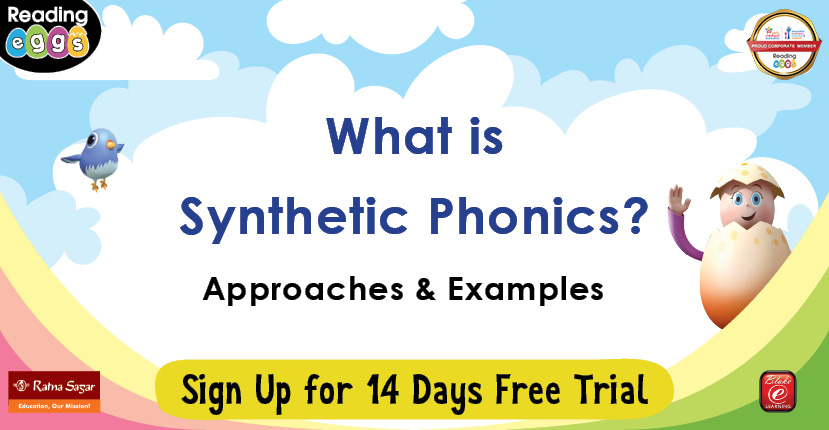What is Synthetic Phonics? - Approaches/ Programme & Examples
What is phonics and why are they important?
Phonics is an interactive way to teach reading, the letter-sound combination, and their use in reading, writing, and spelling. Initially, the child acquires the pronounced words and their sounds by observing his surroundings. Later on, the academic curriculum makes him familiar with the parallel rules and regulations associated with the English Language. The five main types of phonics are:
- Synthetic phonics
- Analytic phonics
- Analogy phonics
- Embedded phonics
- Phonics through spelling
Among these types, synthetic phonics sound chart ensures that the children learn how to read quickly and skillfully. The English language has diverse words with the same sounds from different letters or a combination of letters. So, synthetic phonics resources give them the strategies to decode words and interpret them correctly. 
What is Synthetic Phonics?
If recognised by spelling and its meaning, the term synthetic addresses something artificial or man-made. A fanciful add-on in the natural frame! However, the term ‘synthetic phonics’ means synthesising or mixing multiple sounds to make a word for children to read. It progresses from part to whole i.e., children start with the smallest of the sounds and then move on to the complex ones. This concept makes them familiar with:
- The sound and the letter name
- Composition of spoken words with different sounds
- All 44 sounds of the English language
- Blending sounds in a word
- Listening carefully to learn to spell words
- Different ways to represent every sound
- Camera words (high-frequency irregular words) in developing the required skills for reading complete sentences
The recent analysis reflects that a child’s academic curriculum should follow a systematic and categorical approach. Well, what qualifies the synthetic phonics approach as the most effective one, we are running out of a number of reasons. So, here are the best ones to convince you as a teacher or parent to utilise synthetic phonics approach to teach your child how to read:
- Simple to complex learning
We are all aware that the English alphabet has 26 letters and 44 unique sounds. These sounds have different ways to pronounce when combined with different letters. Synthetic phonics approach teaches the child these 44 sounds from the very beginning to the complex level. Synthetic phonics sound chart creates a path that illustrates a systematic pattern in the learning process. To start off, the children will be taught the unique sound associated with the individual letters. Then, the level of understanding is enhanced by combining multiple sounds with letters.
- The foremost strategy of decoding letters
The children must start with blending to read words. There are many programmes that help the children to get familiar with all the 26 alphabetical sounds. Reading Eggs is such a unique and comprehensive programme that helps the child to grasp the smallest of these letter sounds. There are animated videos, interactive modules, and activities to keep up the child’s knowledge and entertainment. Reading consists of decoding or breaking down small words into separate sounds. These can later be combined to read a new word.
- The art of learning spelling
Spelling is the inverted channel of reading. The children are required to recognise the sound and then match a letter that makes such sound. However, in a synthetic phonics approach, the words are created with breaks with the help of grapheme/phoneme. For instance, if there is any word to be created with ‘oo’ e.g., ‘foot’. We focus on building the word from the ground and then decoding that word. Foot will be ‘f’, ‘oo’, ‘t’. By this method, children learn graphemes and phonemes quickly. Regular practice of the word will make them masters of spelling. Children will begin by learning the easiest sounds and then progressing towards the difficult ones. The series is given below: The single letter sounds like vowel sounds which are a, e, i, o, u. The consonant blends like br, cl, bl, fr, and so on. The consonant digraphs like sh, ch, th, and so on. The vowel digraphs like oo, oa, and so on. Lastly, the trigraphs like ong, ing, air, ear, and so on.
Advantages of Synthetic phonics
- Most effective: Synthetic phonics is the best way, to begin with, reading. Its systematic approach helps the child to proceed in a structured manner and grasp the know-how of reading and spelling.
- Explicit approach: The children are very clear of the next steps and begin reading small words in less time of practising. But it is advised to help them with regular practice of words and their sounds.
- Language decoding without context: The language codes, phonemes, and graphemes are applied well in the synthetic phonics approach so that the children do not have to be dependent on images or context while reading. It builds a new skill of reading comprehension in them.
A rigorous and sequential approach to the reading curriculum develops the child’s fluency, confidence, and love for reading. Reading Eggs closely connects phonics knowledge with the effective implementation of skills while reading. Building on initial phonemic awareness and simple letter-sound recognition, children learn how one phoneme can sometimes be represented by two or more letters, such as /sh/ or /igh/. It also shows children how a single phoneme can be represented in several ways, such as /ee/ as in sea, /ea/ as in sea, and /ie/ as in field. Children also learn how a single letter can represent more than one phoneme, such as /o/ in go, and /o/ on top. The programme includes over 3500+ online books for kids — each ending with a comprehension quiz that assesses your child’s understanding. You may sign up your child for a 14 days free trial of the Reading Eggs programme by clicking on this button below.
